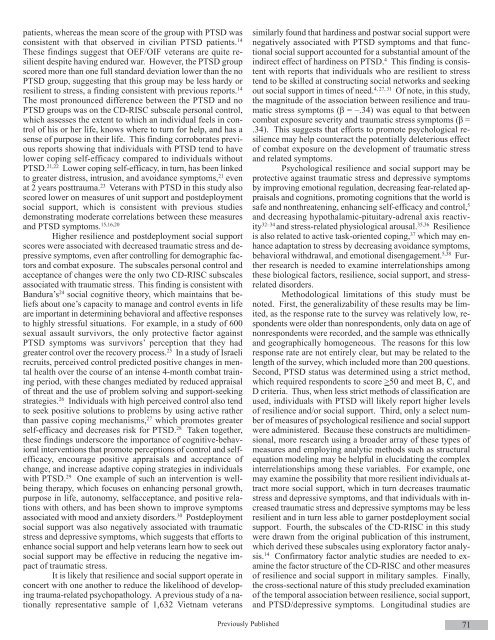Summer - United States Special Operations Command
Summer - United States Special Operations Command
Summer - United States Special Operations Command
You also want an ePaper? Increase the reach of your titles
YUMPU automatically turns print PDFs into web optimized ePapers that Google loves.
patients, whereas the mean score of the group with PTSD wasconsistent with that observed in civilian PTSD patients. 14These findings suggest that OEF/OIF veterans are quite resilientdespite having endured war. However, the PTSD groupscored more than one full standard deviation lower than the noPTSD group, suggesting that this group may be less hardy orresilient to stress, a finding consistent with previous reports. 14The most pronounced difference between the PTSD and noPTSD groups was on the CD-RISC subscale personal control,which assesses the extent to which an individual feels in controlof his or her life, knows where to turn for help, and has asense of purpose in their life. This finding corroborates previousreports showing that individuals with PTSD tend to havelower coping self-efficacy compared to individuals withoutPTSD. 21,22 Lower coping self-efficacy, in turn, has been linkedto greater distress, intrusion, and avoidance symptoms, 21 evenat 2 years posttrauma. 23 Veterans with PTSD in this study alsoscored lower on measures of unit support and postdeploymentsocial support, which is consistent with previous studiesdemonstrating moderate correlations between these measuresand PTSD symptoms. 15,16,20Higher resilience and postdeployment social supportscores were associated with decreased traumatic stress and depressivesymptoms, even after controlling for demographic factorsand combat exposure. The subscales personal control andacceptance of changes were the only two CD-RISC subscalesassociated with traumatic stress. This finding is consistent withBandura’s 24 social cognitive theory, which maintains that beliefsabout one’s capacity to manage and control events in lifeare important in determining behavioral and affective responsesto highly stressful situations. For example, in a study of 600sexual assault survivors, the only protective factor againstPTSD symptoms was survivors’ perception that they hadgreater control over the recovery process. 25 In a study of Israelirecruits, perceived control predicted positive changes in mentalhealth over the course of an intense 4-month combat trainingperiod, with these changes mediated by reduced appraisalof threat and the use of problem solving and support-seekingstrategies. 26 Individuals with high perceived control also tendto seek positive solutions to problems by using active ratherthan passive coping mechanisms, 27 which promotes greaterself-efficacy and decreases risk for PTSD. 28 Taken together,these findings underscore the importance of cognitive-behavioralinterventions that promote perceptions of control and selfefficacy,encourage positive appraisals and acceptance ofchange, and increase adaptive coping strategies in individualswith PTSD. 29 One example of such an intervention is wellbeingtherapy, which focuses on enhancing personal growth,purpose in life, autonomy, selfacceptance, and positive relationswith others, and has been shown to improve symptomsassociated with mood and anxiety disorders. 30 Postdeploymentsocial support was also negatively associated with traumaticstress and depressive symptoms, which suggests that efforts toenhance social support and help veterans learn how to seek outsocial support may be effective in reducing the negative impactof traumatic stress.It is likely that resilience and social support operate inconcert with one another to reduce the likelihood of developingtrauma-related psychopathology. A previous study of a nationallyrepresentative sample of 1,632 Vietnam veteranssimilarly found that hardiness and postwar social support werenegatively associated with PTSD symptoms and that functionalsocial support accounted for a substantial amount of theindirect effect of hardiness on PTSD. 4 This finding is consistentwith reports that individuals who are resilient to stresstend to be skilled at constructing social networks and seekingout social support in times of need. 4, 27, 31 Of note, in this study,the magnitude of the association between resilience and traumaticstress symptoms (β = –.34) was equal to that betweencombat exposure severity and traumatic stress symptoms (β =.34). This suggests that efforts to promote psychological resiliencemay help counteract the potentially deleterious effectof combat exposure on the development of traumatic stressand related symptoms.Psychological resilience and social support may beprotective against traumatic stress and depressive symptomsby improving emotional regulation, decreasing fear-related appraisalsand cognitions, promoting cognitions that the world issafe and nonthreatening, enhancing self-efficacy and control, 5and decreasing hypothalamic-pituitary-adrenal axis reactivity32–34 and stress-related physiological arousal. 35,36 Resilienceis also related to active task-oriented coping, 37 which may enhanceadaptation to stress by decreasing avoidance symptoms,behavioral withdrawal, and emotional disengagement. 5,38 Furtherresearch is needed to examine interrelationships amongthese biological factors, resilience, social support, and stressrelateddisorders.Methodological limitations of this study must benoted. First, the generalizability of these results may be limited,as the response rate to the survey was relatively low, respondentswere older than nonrespondents, only data on age ofnonrespondents were recorded, and the sample was ethnicallyand geographically homogeneous. The reasons for this lowresponse rate are not entirely clear, but may be related to thelength of the survey, which included more than 200 questions.Second, PTSD status was determined using a strict method,which required respondents to score >50 and meet B, C, andD criteria. Thus, when less strict methods of classification areused, individuals with PTSD will likely report higher levelsof resilience and/or social support. Third, only a select numberof measures of psychological resilience and social supportwere administered. Because these constructs are multidimensional,more research using a broader array of these types ofmeasures and employing analytic methods such as structuralequation modeling may be helpful in elucidating the complexinterrelationships among these variables. For example, onemay examine the possibility that more resilient individuals attractmore social support, which in turn decreases traumaticstress and depressive symptoms, and that individuals with increasedtraumatic stress and depressive symptoms may be lessresilient and in turn less able to garner postdeployment socialsupport. Fourth, the subscales of the CD-RISC in this studywere drawn from the original publication of this instrument,which derived these subscales using exploratory factor analysis.14 Confirmatory factor analytic studies are needed to examinethe factor structure of the CD-RISC and other measuresof resilience and social support in military samples. Finally,the cross-sectional nature of this study precluded examinationof the temporal association between resilience, social support,and PTSD/depressive symptoms. Longitudinal studies arePreviously Published 71
















